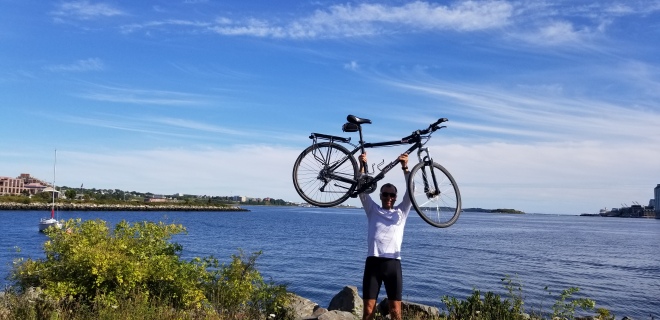August 29th. Well, the long ride to Bridgewater helped dodge a storm. Tropical storm Erin was supposed to bring heavy rain to all of Nova Scotia, but it only brought it to the northwest shore. Bridgewater was overcast, but with only occasional rain. Having anticipated a day of torrential rain, I planned to take cover. So, without the rain, it became a day of exploring and taking care of little things. Even chatted for a while with a small group that included a couple of motorcyclists from New Zealand who were touring the Maritimes.
The next day was the trip to Halifax. End game!
The southeast shore of Nova Scotia is heavily touristed, so the trail was well maintained. After starting out using roads so as to enjoy the scenery of shoreline towns, I switched to the trail for a more tranquil ride. There were a lot of cyclists on the trail. But it was not as hilly as I expected, so the 120km to Halifax seemed leisurely – it’s amusing that I can say that.
The snake in the picture is only about 7 inches long.

Peggy’s Cove and Halifax are particularly worth the visit. Halifax’s immigration museum (Pier 21) preserves the arrival point for over a million immigrants who came to Canada between 1938 and 1971 – I arrived in 1963. Peggy’s Cove is beautiful by day (when the ocean is calm), and spectacular in the evening during sunset. And some of the best seafood in NS can be had along the road to Peggy’s Cove from Halifax.
So, the arrival in Halifax (August 30th) marked the end of the journey that started in Vancouver. Altogether, the ride was more than 6,700km over 57 (non-consecutive 🙂 ) days. During that time, the ascents added up to almost 26km. Going across Canada at that pace has its rewards – you see things up close in ways you would miss by driving the same route. It is a trip well worth taking for anyone who enjoys cycling – the stamina part of it is not that important since anyone can do it at their own pace. My only regret is that I wasn’t able to detour more often and take in more of the Canadian experience…but there is always another time!






















 The only drawback of those trails is that, particularly around Sharbot Lake, young guys with ATVs are damaging the trail. This is unfortunate since the trail there is designated as part of the Trans-Canada Trail (or The Great Trail as it is now known). In significant sections, it’s possible to use country roads with very little traffic in place of the trail: e.g. between Campbellford and Tweed.
The only drawback of those trails is that, particularly around Sharbot Lake, young guys with ATVs are damaging the trail. This is unfortunate since the trail there is designated as part of the Trans-Canada Trail (or The Great Trail as it is now known). In significant sections, it’s possible to use country roads with very little traffic in place of the trail: e.g. between Campbellford and Tweed.
